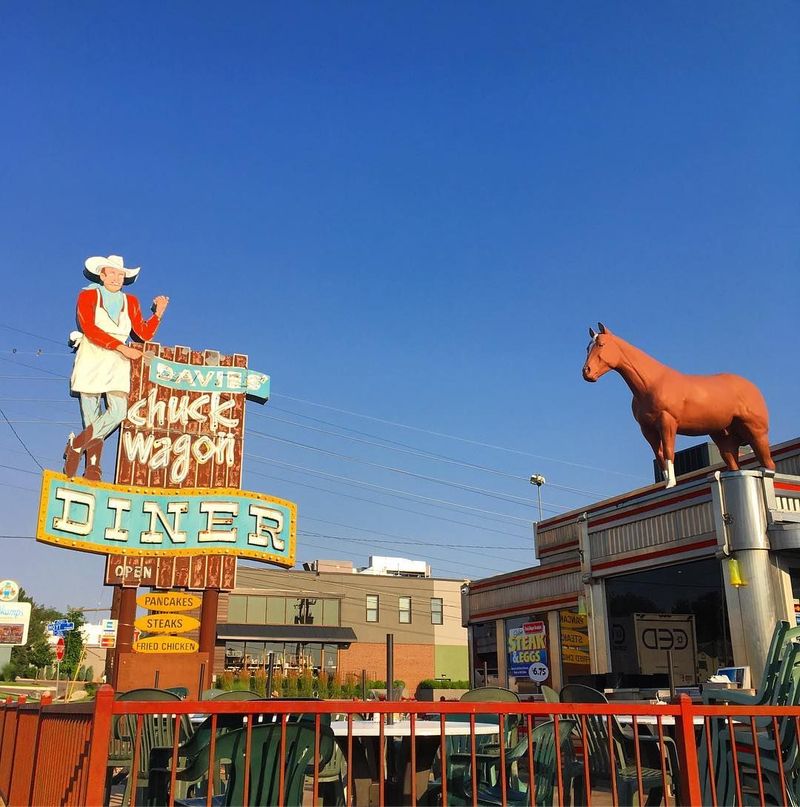Slide into a chrome-edged time capsule where the Rockies meet stainless steel. Davies’ Chuck Wagon Diner fuses East Coast diner grit with Western showmanship—think pink-and-gray formica, a towering neon cowboy, and a fiberglass palomino beckoning travelers off US 40. Built in 1957 as a shipped-in prefab, it still sizzles with griddles, jukebox selectors, and the hum of local lore. If you love American roadside culture, this Lakewood landmark delivers a rare, living slice of mid-century magic.
A Western-Themed Diner With East-Coast Origins
Davies’ Chuck Wagon Diner began with William Lyman Davies, a seasoned East Coast restaurant supervisor who believed Colorado deserved a bona fide diner. In 1957 he ordered a prefabricated stainless-steel model from Mountain View Diners, Inc. in New Jersey and shipped the 46-ton beauty by rail to Lakewood. He planted it at 9495 W Colfax Ave—historic US 40—where traffic rolled between Denver and the mountains. To announce its Western twist, he added oversized roadside art: a 36-foot neon cowboy in an apron and a life-size fiberglass palomino horse. Instantly recognizable, the ensemble shouted “Western diner meets roadside Americana.” The result feels both transported and tailored—East Coast manufacturing savvy wrapped in Rocky Mountain swagger. It’s a road-era origin story with a cinematic entrance.
Architecture, Authenticity & Rarity
Architecturally, Davies’ is a rare survivor: a mid-century prefabricated steel diner shipped from New Jersey, assembled intact in Colorado. According to SAH Archipedia, it retains stainless-steel cladding, pink and gray formica counters, mirrored walls, and classic booth jukeboxes—hallmarks of the type. Weighing roughly 46 tons, it’s an industrial artifact disguised as a cheerful roadside pit stop. Inside, chrome trim glints under neon and glass block glow, while the long counter anchors conversation and coffee. Dinerville and preservation records note its listing on the National Register of Historic Places, underscoring regional scarcity. Most such diners clustered in the East; few traveled this far or lasted this long. Here, authenticity isn’t curated—it’s continuous, baked into the rivets, steel ribs, and the lived-in rhythm of daily service.
Roadside Icon on US 40
Set along Colfax Avenue—historic US 40—Davies’ leverages perfect roadside theater. The 36-foot neon cowboy and the palomino horse act as kinetic billboards, framing the diner as a stage for American car culture. In the 1950s and 60s, motorists sought landmarks that signaled food, fun, and fast service; Davies’ still delivers that beacon-like promise. Its survival also showcases the dwindling prefab diner format: Historic Structures reports thousands once existed, now dramatically fewer remain. This makes Davies’ not only photogenic but essential to understanding mid-century travel habits. The East-meets-West hybrid—steel diner bones, Western motifs—creates an identity both playful and instructive. Park out front, watch the neon warm up at dusk, and you’ll feel the lineage of America’s open road.
Food, Legacy & Local Life
Beyond the chrome, the menu keeps regulars loyal and travelers curious. Early years brought 24-hour breakfasts, hearty plates for truckers, tourists, and night owls. Today, you’ll still find diner staples anchored by community favorites—Roadtrippers reviewers often praise the chicken-fried steak as a standout. Portions are generous, coffee is constant, and the counter invites conversation. Over decades, the place became a neighborhood institution where staff know names, orders, and stories. Atlas Obscura notes its cultural resonance: a living diner that nourishes both appetite and memory. The clink of plates, the jukebox selectors at booths, and the steady sizzle at the griddle forge continuity. In an era of quick turnover, Davies’ proves that comfort food and familiar faces are a powerful recipe.
Design Details Worth Seeking
Arrive with an eye for mid-century craft. Outside, study the stainless-steel panels, ribbing, and rounded corners that define Mountain View Diners’ streamlined aesthetic. Inside, note pink-and-gray formica counters, chrome-edged stools, mirrored walls, and those charming booth-side jukebox selectors—tiny time machines for nickels and nostalgia. The signage ensemble is key: the towering neon cowboy in an apron and the fiberglass palomino telegraph whimsy and Western pride. Look closely at letterforms, neon tubing, and the patina on steel to appreciate decades of service. These details aren’t retrofitted; they’re original fabric, remarkably intact. Together, they compose a visual syllabus on American diner design, translating the optimism of the 1950s into a tactile, everyday experience that still invites a sit-down, a slice of pie, and a second cup.
Historic Status & Preservation
Preservationists highlight Davies’ as a rare Western example of a prefab steel diner, a type once common back East. Dinerville and SAH Archipedia document its historic qualities and National Register listing, which recognizes integrity of materials, workmanship, and setting. The structure’s survival—still operating in its original roadside context—strengthens its case as cultural infrastructure, not just nostalgia. Historic Structures notes that the nation’s prefab diner population has dramatically declined since the 1950s, amplifying this site’s importance. Stewardship here means balancing daily wear with fidelity to original finishes. When a community eats in a landmark, preservation becomes participatory. Every breakfast rush validates the building’s intended use and ensures the neon cowboy keeps lassoing attention for future generations.
Visiting Tips & Photo Plan
Plug in 9495 W Colfax Ave, Lakewood, CO 80215 and arrive hungry. Expect a classic full-service menu, pancake breakfasts, and mid-century ambience—chrome trim, counter seating, and booth jukebox selectors. For history spotting, seek the neon cowboy and the palomino horse outside, and original finishes inside. Photographers: come late afternoon for building detail, then blue hour for neon glow and traffic light trails along US 40. Mind reflections on steel; polarizers help, and a low angle dramatizes the signage. Weekends get busy—consider off-peak for interior shots and a relaxed meal. Nearby, explore Colfax’s layered roadside heritage to round out your retro itinerary.










